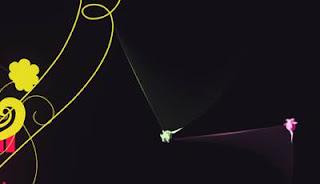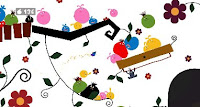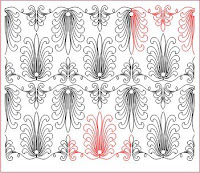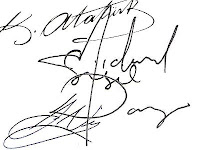
Eden. The unknown garden where players can guide their Grimp through space and along what can only be describe as some kind of plant like structure. Monocot, dicot, or any other known classification is completely lost to the plant like elements of this world. And yet, as I swing from stem to stem, suspended by my own silken string and dream like sense of momentum and gravity, I make my way to the glowing goal. The Spectra. I'll excuse the Pollen Prowlers I destroyed along the way some other time. I think I'm drawn like the pollen to a destination out of view. Like an innocent child's eye I follow. For in this world, sometimes plants grow down and away from the sun.
![]() PixelJunk Eden (PJE) has the kind of look that instantly attracts my attention. Everything is composed of flat colors and simple shapes that layer together nicely to sit somewhere between LocoRoco, Victorian patterns, and the tail ends of a couple of illegible signatures. It's quite apparent that this game has a strong sense of style and a sound scape to match. If Pixel Junk Eden was just about the visuals, I'd probably have to paint my walls to match the various looks and levels in the game. Existing on the verge of a free internet flash game or indie games, Pixel Junk Eden has broken into the world of the Playstation Network, a place where smaller budgets, fresh ideas, and perhaps more concentrated efforts can be pushed into our consciousness.
PixelJunk Eden (PJE) has the kind of look that instantly attracts my attention. Everything is composed of flat colors and simple shapes that layer together nicely to sit somewhere between LocoRoco, Victorian patterns, and the tail ends of a couple of illegible signatures. It's quite apparent that this game has a strong sense of style and a sound scape to match. If Pixel Junk Eden was just about the visuals, I'd probably have to paint my walls to match the various looks and levels in the game. Existing on the verge of a free internet flash game or indie games, Pixel Junk Eden has broken into the world of the Playstation Network, a place where smaller budgets, fresh ideas, and perhaps more concentrated efforts can be pushed into our consciousness.
Many have played this game and in their sleepy stupor tried to describe it as being sucked into a trance or dream like state. I can't say that I had any such experience with the game, but in my now wakened state I can say that Pixel Junk Eden is a platformer. Now that the genre has been identified, it only follows to identify the game's mechanics, game elements, and design choices that attempt to bring everything together to create the gameplay. If you have a PS3, download the demo and play the game for yourself. If you don't, watch this video before moving on.
Eden: unknown garden = setting of game
Grimp = player species/character
Pollen Prowlers = pollen filled balloons (level element)
Plant Seeds = plants that bloom when filled with pollen and activated (level element)
Spectra - collect to complete level goals.
Crystals - to keep Oscillator tuned = time extenders
Oscillator - level timer
The primary functions of Pixel Junk Eden are STRING JUMP, SWING, and RELEASE. The secondary functions are MOVE (while traveling through the air), REWIND SILK, and ATTACK. The basic idea in PJE is to move around the environement by creating silken lines and releasing them from either a SWINGing or JUMPing state. The Grimp, player character, can stick to surfaces allowing players to platform to increasingly higher areas in the level.
The plant like level elements are the platforms the player needs to utilize to progress through a level. When a plant is not available, players can grow new ones by filling plant seeds with pollen and touching the seeds directly. In this way, the plant seed design encourages the use of the primary function to transform the level by creating new platforms. Another type of level transformation comes from gripping to the tip of a flexible stem or leaf. The Grimp's body weight weighs down the leaf drooping the leaf and other leaves that may be attached to it.
 For a game that's so simple, there is a high amount of clutter in the core design. The clarity in the relationship between the player and the level elements is weakened by the player's ability to grip to or pass through the level elements. AT any given time, the player can interact with the level in one of these two ways. For a platforming game, this means the function/interaction with the platforms can be turned on or off at any time. By oscillating between these two states of interaction, PJE fails to create a strong sense of stability from the platform arrangements. Instead of being a distinct, solid, even brick like element for the player to maneuver around, the platforms in PixelJunk Eden are more like clouds; unstable, whimsical, and muddled. Because the plant platforms doesn't effectively limit how the player can platform but where they can in a general sense, the difference between platforming one way or the other is severely diminished. In other words, without a sufficient level of restriction, variability and difference become diminished and therefore expression is practically non existent.
For a game that's so simple, there is a high amount of clutter in the core design. The clarity in the relationship between the player and the level elements is weakened by the player's ability to grip to or pass through the level elements. AT any given time, the player can interact with the level in one of these two ways. For a platforming game, this means the function/interaction with the platforms can be turned on or off at any time. By oscillating between these two states of interaction, PJE fails to create a strong sense of stability from the platform arrangements. Instead of being a distinct, solid, even brick like element for the player to maneuver around, the platforms in PixelJunk Eden are more like clouds; unstable, whimsical, and muddled. Because the plant platforms doesn't effectively limit how the player can platform but where they can in a general sense, the difference between platforming one way or the other is severely diminished. In other words, without a sufficient level of restriction, variability and difference become diminished and therefore expression is practically non existent.
The function of plant like platforms, or the lack thereof, makes it difficult to pin down the minimum degree of difference for PixelJunk Eden. Where Mario is quantified by the brick unit, PJE is much more analog. The Grimp SWINGs in a fluid circle, STRING JUMPs through space in smooth arcs, and grips to curved plants that sway listlessly back and forth. If it's difficult to draw distinct lines to quantify the primary mechanic because of how organically curved the design is, then trying measure anything accurately when platforming from the vague clouds of distinction that are the plant elements is nearly impossible.
Perhaps what makes finding the minimum degree of difference in PJE the most difficult is the lack of variation in the primary mechanics. Remember how Mario's jump is at least 2 brick units high and at most 5 brick units high? The range of 4 units between the players options and variety to the mechanic that allows them to efficiently make jumps, over shoot, undershoot jumps to adjust their platforming and timing. The levels in Super Mario Bros. are designed around Mario's range making the gameplay experience smooth like clockwork. In PixelJunk Eden, the speed and height gained from a STRING JUMP is equal to the height from a SWING and RELEASE. Without a range of variation, the minimum degree of difference for PJE becomes the full STRING JUMP itself. And with only one type of move to build a level around, the range of possibilities is reduced to one especially considering that the plant platforms don't limit space. In essence, designing a level/game around a primary function without any significant variation is like writing a song with only one note. No matter how many ways you mix up the rhythms, the song can't go anywhere.
The environments in each level are vast. As the player moves around, the camera follows along zoomed in enough so that the player character is about the size of a fly on the TV screen. When SWINGing on a silk line, the camera will zoom out. Unfortunately, even at the zoomed out level, it is difficult to get a clear picture of the surroundings. Because the distance traveled from a single STRING JUMP is quite large compared to the screen size, the developers arranged many of the plant platforms far away from each other. I'm quite aware that the art style and level design were closely woven together to create a garden where plants can grow and hang about in mid air. But, because the function of the plant platforms are partially divorced from their forms, the new form that is established for the plants leans close to the side of "anything goes." In a "normal" game, when plans function as platforms they also often indicate where the ground level is.
As we know the plants in PJE are far from normal. The plants in PJE don't have to connect to the ground or grow upward to indicate which way gravity is pushing. With these plants anything goes. And if at any time, the essential level elements in a platformer (the platforms) can be up, down, sideways, floating, non interactive, or solid, then how can a sense of foundation of normalcy be established? Clearly, the function of the platforms was created as a direct result of the artistic style. In the world of art where anything goes and artists are free to do what they please. But, in a game world form, function, rules, and mechanics are more important than aesthetics. For all these reasons, the level design in Pixel Junk Eden feels very inorganic. Perhaps the inorganic design is supposed to hearken to the dream like quality of the game. Still, even dreams make their own kind of sense.
The camera brings enough problems to the core design on its own, and the multiplayer camera puts an even greater stress on the core design. Like PJE, other games like Super Smash Brothers Brawl are design so that the camera follows the main player and teleports the secondary player to the main player's side if they move off the screen view for too long. When PJE brings the players back together, it costs players a deduction of collected pollen.
If a player SWINGs around too long on a silk line, the string will break jettisoning the little Grimp off into space. Before the line breaks, players can either RELEASE the silk line or REWIND it to where they can grip safely back onto the plant. Once back on the plant, the player is free to SWING again with the only penalty being that the combo count is reset. Because the penalty only involves the the abstract combo system, and the player isn't able to effective chain their combo from one SWING to another, the silk string breaking function creates negative space. It's just one more routine that players will naturally gravitate to because there isn't an alternative.
The open level design in actuality limits the gameplay in PixelJunk Eden. The pollen prowlers seemingly float around randomly throughout the garden. Because of their random nature, collecting pollen involves a little luck with being in the right place at the right time. The pollen, as well as the rest of the level elements, don't interact with each other. Pollen prowlers float through plants and many other level elements.
The interactions are limited between the player and the basic type of pollen prowlers. SWINGing into these pollen filled targets doesn't affect the player at all. The impact doesn't slow down the SWINGing momentum, speed up the SWING, elongate the silk string, or anything else that would feed back into the primary functions of the game. So when pollen prowlers inevitably float by, players will SWING, catch, and repeat without fear of running into anything. The possibility for PJE to reach high levels of emergent gameplay or counterpoint is continually squashed due to the lack of interaction between nearly every game element. Functionally, the basic pollen prowlers are more like coins than Goomba. If a game element isn't a threat to the players health or their ability to reach the goal, then that game element is not an enemy.
Momentum is created when player mechanics layer and/or link into resulting states that create opportunities with a higher amount of risk/reward. Flow is how a game accelerates or creates forward momentum. This factor of gameplay isn't necessarily about speed. More specifically, it looks at how a game's interactions feed back into the player's options/experience like a snowball rolling down hill.
Jumping for the filled plant seeds is the most structured "platformy" part of PJE. By taking careful aim, players test their platforming skills with this all or nothing challenge. Successfully activating a plant seed kicks the player off into a sort of auto-jump similar to how landing on a Goomba JUMPs Mario rebounding him back into the air. It is this kind of interaction/interplay in PJE that I find the most interesting.
But where Mario's rebounding jump is tied to his momentum and direction, players can choose any direction for the rebounding jump in PJE eliminating the link between the STRING JUMP mechanic and the resulting rebound. Without this link, the momentum is reset back to zero. With the limited string SWINGing time and the grip and re-SWING being the primary movement system, Pixel Junk Eden suffers from start-stop flow. Because players have to grip to interact with a plant platform, all of the player's speed and momentum is stopped. Without a way to continually move through the game world, PJE's flow is arrested in this very small, very shallow repeated mechanic cycle.
On top of the shallow mechanics and inorganic level design, PixelJunk Eden features an abstract combo system that rewards players that snag 3 or more pollen prowlers in one SWING. Unfortunately, because of the start-stop nature of the core design, one SWING and the optional RELEASE is the only opportunity the player has to act in the first place. In the same way that the minimum degree of difference of the primary functions limits PJE's platforming possibilities, the string breaking mechanic puts a fairly inflexible limited on the combo system. Additionally, because the pollen prowlers arrangements are random, the combo limit has an element of chance.
Back when I first discussed mechanics on this blog, I defined the primary mechanics as the mechanic(s) that the core gamplay is designed around. The primary mechanic holds the most unique and/or most essential functions in a game. All the other mechanics (secondary/tertiary) are typically designed to support the primary mechanic. In Mario's case, RUN and DUCK layer together with JUMP resulting in greater jump range vertically and horizontally, a more compact jumping size for Big Mario, greater control of one's momentum, and a way to organically adjust the game's difficulty by increasing the pace. This isn't even mentioning how RUN and DUCK layer with each other to create SLIDE, the only way for Big Mario to move forward in a compact size. Because Mario can't slide very far or achieve his maximum ranges without running, these abilities are directly connect to the level design. Without enough running room, Mario can't gain reach running speed. So, keeping Mario moving at top speed, not only increases the speed of the game but creates a flow from linking the possible paths from runways, clearly over obstacles, and onto platforms.
The problem with PixelJunk Eden is that the secondary mechanics don't support the primary mechanics by increasing the range of effects for the primary function or expanding its definition. Let's take a closer look at the mechanics.
STRING JUMP: The set jumping speed takes away from this mechanic's direct quality. Because the same button is used to STRING JUMP, RELEASE, and spin the Grimp to avoid gripping to objects, this mechanic is not individual either. The lack of clarity between SWING JUMPING/SWINGing through level elements and gripping to them eliminates the intuitive quality. The added momentum from STRING JUMPing off of swaying plants is nullified by the level design somewhat diminishing this mechanic's dynamic quality.
SWING: Direct. Because the string isn't affected by the level, and the Pollen Prowlers don't affect the string or trajectory of the SWINGing, this mechanic is not dynamic. Also, gravity isn't a factor when influencing the swing using the analog stick. This makes the mechanic counter intuitive.
RELEASE: Direct. Not individual. This mechanic is as dynamic as it can be.
Out of the three secondary mechanics (MOVE, REWIND, ATTACK) only REWIND layers with any of the primary mechanics. By pulling in the silk, players can reduce the radius of the circle thus increasing their rate of rotation. But even this secondary support is weakened by the overall lack of interaction with the silk string and lack of significant physics based platforming. PixelJunk Eden is like taking away Mario's WALK, RUN, and DUCK mechanics so that the only way to move is by JUMPing and moving forward in the air. If JUMPing was the only way for Mario to get around, then Super Mario Bros. would get very old very fast. This trend shows that adequate support from secondary mechanics is more important to the overall gameplay than the quality of the primary mechanic alone.
From what I've played, the core design of PixelJunk Eden doesn't contain enough solid design for me to spend any more time with the game. PJE's mechanics are shallow and cluttered, level design and style is counter intuitive, and the lack of meaningful interactions keeps the flow and counterpoint potential down. With so many design choices holding the game back, I seriously doubt that any additional game elements featured in later levels will somehow mask, address, or fix any of the issues raised.
To the Repair Shop: PixelJunk rEden
Vision/Attitude
- The first change involves the project attitude. Gameplay needs to be prioritized over graphics and sound. Form fits function and by extension function creates form are the two design tenets that must guide a game like PixelJunk Eden.
Mechanics/Functions
- Primary mechanic can use physics to increase the mechanic's dynamic quality. Check out this video from an earlier version of the game. The platforming/primary mechanics look much tighter. And the floatyness of the jumps is gone, which would help the flow. The changes that were made form this video were for the worse.
- There needs to be a way to conserve at least some of the momentum from a SWING JUMP.
- The STRING JUMP mechanic needs to be significantly smaller than the SWING and RELEASE style jump. Doing this will give the platforming jump more range which will give each jump a distinct and clear function.
- Add the CRAWL mechanic. This mechanic will accentuate and work very well with the organically curved style of the game. Being able to crawl along the plants will allow players to carefully and accurately move into position instead of having to awkwardly adjust their position in quick jumpy spurts. In the same way that Mario's WALK mechanic enhances the JUMP mechanic, the CRAWL mechanic will give the player a greater sense of control over the environement.
- Make all level elements solid. Without the ability to swing through the plant platforms, the arrangement of the plants will have to be much cleaner ie. less wild branches (see grey picture above). Fortunately, the new CRAWL mechanic will allow the player to crawl around to reach positions with more SWINGing room.
- Make the silk string interact with the level/enemies/player elements in dynamic and intuitive ways. The Grimp and silk should achieve a playful function like performing yo-yo tricks.
- Take out the string break mechanic.
- Add a way for the player to make their string longer. Not only would this increase the difficulty by allowing the Grimp to swing in wider circles and thus increases the potential for interactions with the string, but it would allow for more complex yo-yo style string tricks and bigger, bolder platforming. Perhaps use the Drill Dozer system where the length of the string increases with every Spectra collected. In this way, the levels can have a greater level of forward momentum and flow.
- The combo system doesn't create layered gameplay /counterpoint. Also, it's not a very good system because of the limitations of the SWING time. Instead of employing an abstract system, it would do the game a world of different if the combo system was based on concrete elements. In the same way that Mario can keep his momentum and combo jumps off the backs of his enemies, PJE's combo system needs to be organic even at the sacrifice of points and online leaderboards. With a new organic combo system, the string break mechanic is no longer need to limit the player.
- Make much more concrete, and design some solid levels to accentuate the mechanics. For example, the bending plants and swaying branches should significantly affect the momentum and swing trajectories of the primary mechanics. In this way, the level elements provide ways to dynamically shape the platforming while creating momentum and flow at the same time. Focus on Bros.3 style bite sized chunks instead of huge confusion open worlds of nonsense. Then, find ways for the bite sized chunks to link together dynamically to create some truly innovative and original levels.
- The enemies need to be simple like Super Mario Bros. enemies. Also, they need to interact with the level and the player mechanics in interesting ways. The more interplay the better. Perhaps an aphid like creature could crawl along the plant platforms. Players could use their silk to trap and eliminate these creates like spiders.
Multiplayer
- To create true multiplayer co-op gameplay, there must be interplay with the player's mechanics (preferably the primary mechanics). Co-op isn't very cooperative if both players can simply "do their own thing" and completely ignore each other. Being able to interact with one's partners is essential. In Super Smash Brothers tournament level team play, everyone plays with friendly fire on. For us, watching out for our partners, accidentally hitting them, and the ability to save them is far more interesting than not being able to.
- In PJE, players should be able to CRAWL on friend's silk lines in addition to creating a silk line off off their friends swinging body. The physics involved in such a scenario is beyond exciting. See image below.
 Yellow is swinging to the left, while pink is swinging upward.
Yellow is swinging to the left, while pink is swinging upward.
- With the new momentum based platforming, stringing, SWINGing and JUMPing off of partners will be easier and more effective than ever.
I believe the write up for PixelJunk Eden is so long because it's a strange game that is so close and yet so far from greatness. Fully explaining why PJE exists in this awkward space, required lots of word space. And to think, all of this from only playing the demo.


